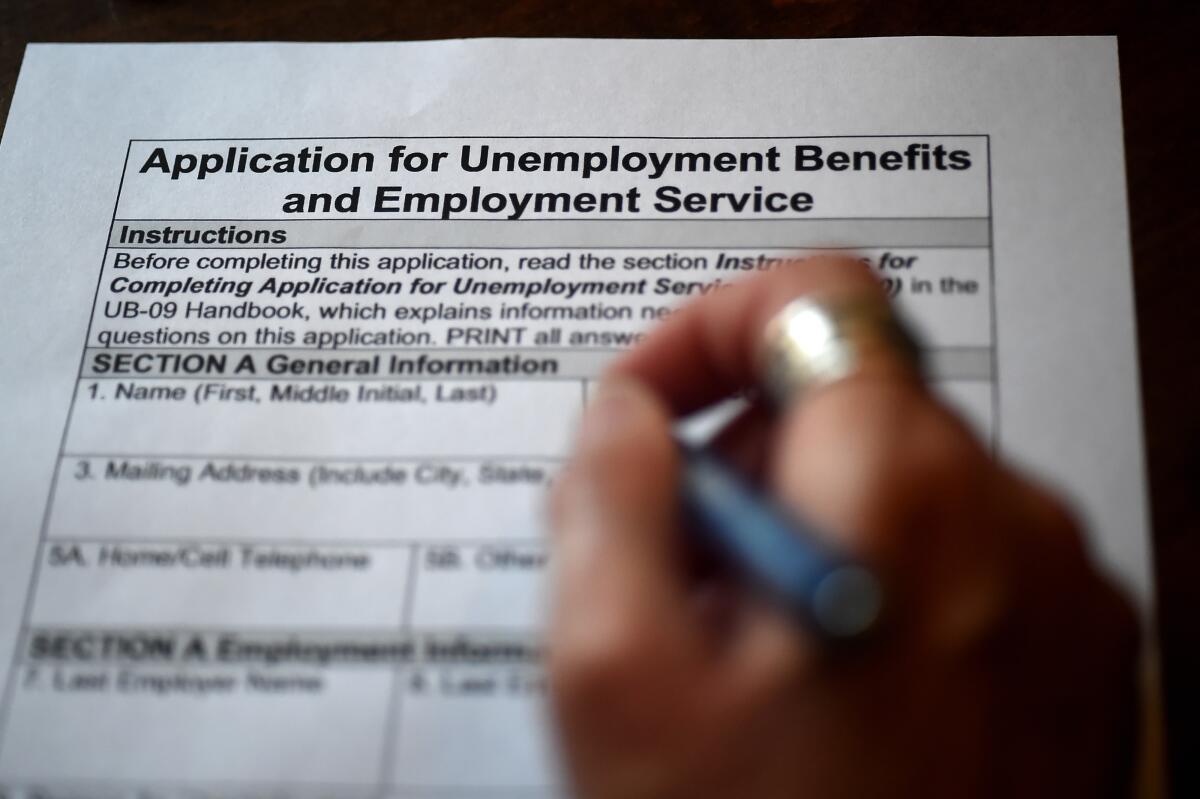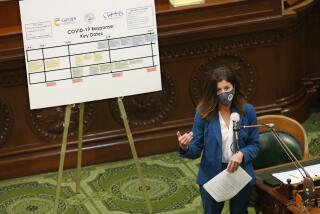How budget cuts and restrictive policies hobbled the unemployment insurance system

- Share via
WASHINGTON — As the number of laid-off workers seeking jobless benefits grew by nearly 4 million in just the last week, it’s little surprise that the systems charged with responding are overwhelmed.
For decades, state and federal agencies have seen their budgets cut, staffs reduced and their operations hobbled by increasingly restrictive rules.
The result today is more pain and financial damage for millions of Americans who suddenly lost the paychecks they needed to pay rent, mortgages, grocery bills and other basic living expenses while the coronavirus outbreak raged.
Swamped by 30 million new filings since mid-March, state employment agencies are starting to catch up, although millions of people are still waiting for their first check.
In March, states issued new jobless benefits to 1.7 million people, more than triple the number paid out in February, according to U.S. Labor Department figures released this week. That’s still just 14% of the nearly 12 million new workers who applied for benefits in March.
Many workers can’t afford to wait that long. So sharp and immediate is the financial impact that millions of Americans have sought deferrals on credit card payments and have been later than usual in paying their rents, according to surveys and reports from lenders.
The Federal Reserve said last year that 4 in 10 U.S. households would have some difficulty covering a $400 emergency expense. Now, not getting the promised unemployment benefits means they’re closer to the edge of financial disaster.
“People are selling their cars, they’re trying to get help delaying their car payments,” said Terry Brewington, the United Steelworkers local leader at the Goodyear plant in Fayetteville, N.C. “You can’t make up when you’re already behind.”
It’s not that Washington failed to see the hardships that an unprecedented surge in unemployment would bring. U.S. lawmakers and some in the Trump administration knew there were deficiencies in the unemployment program. Money to help states administer jobless benefits went out in an earlier round of pandemic relief aid in mid-March.
And the $2.2-trillion package later in the month provided more than $250 billion to boost unemployment payments.
An unprecedented $600 a week through July will be paid to each jobless worker on top of whatever each state authorized.
Unemployment benefits were also expanded to cover independent contractors and others who ordinarily would not qualify because they weren’t wage earners whose employers paid taxes that funded the unemployment insurance program.
Duration of payments was extended by 13 weeks. And financial incentives were provided to states to deliver checks quicker.
Even so, state employment agencies’ capabilities had been eroding through decades of changing technology and budget-balancing cuts, especially after the Great Recession of 2008-09.
So when millions of people suddenly lost jobs, hotlines created to help jobless workers navigate the systems froze up.
Antiquated claim-processing systems crashed; fixing them often proved difficult because many used coding and other computer systems that had been obsolete for years.
And were it not for a temporary easing of restrictive rules designed to prevent freeloading and undeserved payments, the processing of claims would have been even more hobbled.
The problems are particularly bad in states such as Florida, where hundreds of people waited in car lines to file paper applications. They couldn’t call for help because years earlier the state had done away with its telephone service to help jobless claimants through the process.
North Carolina has been another trouble spot for those laid off by the pandemic, partly because of shortcomings in the state’s processing system and partly because North Carolina and other politically conservative states drove payment levels low and made it harder for jobless workers to qualify. Only 6% of new applicants in March got their first payment that month, compared with 14% nationally.
Jenni Propst, 43, lost her work as a lighting technician in Charlotte, N.C., in mid-March. She filed for benefits on March 17, staying up nearly all night because the online system was overloaded and kept freezing up. Getting through to the call center, she said, was hopeless. Finally, in the middle of the night, she finished the application.
It wasn’t until one month and two days later that Propst got her first unemployment check. She has religiously filled out weekly certifications for continuing benefits, even though some of the questions, she said, made her feel as though the system was trying to trick her so that she would not be eligible.
“What North Carolina [usually] gives isn’t enough,” Propst said. The state once paid a maximum $525 a week. It’s now down to $350. “I’m very scared about what’ll happen after all of the extra fed funds run out,” she said.
The nation’s unemployment insurance system is a legacy of the Great Depression and New Deal reforms, designed as a joint federal-state project. Until COVID-19, the U.S. government gave little funding to maintain, let alone upgrade, what was meant to be a safeguard for workers and their families against financial hardships.
Governors and legislatures in many states pushed to slash benefit amounts and make it more difficult for jobless workers to qualify for the aid.
The process became so demanding that only 3 out of 10 unemployed people nationally were able to collect unemployment insurance last year, compared with almost 4 out of 10 before the Great Recession, according to Labor Department reports.
In Florida, North Carolina, Louisiana and a few other states, only 1 out of 10 jobless workers ended up collecting unemployment benefits in the days before COVID-19. That compares with 4 or 5 out of 10 in Massachusetts, New Jersey and California, among others.
What’s more, for decades the national standard was that eligible jobless workers could count on receiving unemployment checks for up to six months, so long as they kept on looking for work.
Today, benefits can run out in as little as 12 weeks in about 10 states. The short duration means a greater share of workers are exhausting their benefits before they find new jobs.
“What it shows is that the system is broken,” said David Balducchi, who spent 35 years at the U.S. Department of Labor working on employment legislative and budget policy and is now an independent consultant on workforce development issues.
And the program was quietly getting worse – until the pandemic spotlighted the holes in the safety net. “You wouldn’t know about that unless you had an avalanche of jobless,” he said.
To be sure, the surge of unemployment filings has been unprecedented. During the Great Depression in the 1930s, an estimated 1 out of 4 workers was jobless, but the total unemployed then was about 13 million to 14 million – fewer than half the numbers laid off in just the last six weeks.
“I don’t think anyone ever imagined having to cope with the volume of claims we’ve seen since the middle of March. The system wasn’t designed or staffed for this,” said Katharine Abraham, a former commissioner of the Bureau of Labor Statistics and now economics professor at the University of Maryland.
Even if state systems improve in the short term, things may get worse. Almost all of the federal boost to the unemployment insurance program is temporary. When the pandemic money runs out, will the federal government go back to its old ways?
Since the 1980s, congressional funds supporting unemployment insurance have fallen 30% in inflation-adjusted terms, Balducchi said.
As for the states, will they simplify applications, enhance benefits and invest more in the operation of the unemployment insurance systems?
During the Great Recession and slow recovery, three dozen states borrowed money from the federal government to cover deficits in their unemployment trust funds. California didn’t pay back what it owed until 2018 and is now looking to borrow again.
George Wentworth, a 35-year veteran of the Connecticut Labor Department, is hoping states reverse some of the extra documentation that some had required of workers.
“There was a big spike in terms of work-search denials,” he said. “They made it a much more difficult procedural bar for people to receive their weekly unemployment insurance payments.”
Job-search requirements have been waived during this period of pandemic.
“Thank God the federal government stepped in during this crisis to increase the amount and duration of benefits,” said MaryBe McMillan, president of North Carolina State AFL-CIO. “This crisis has really exposed the massive holes in our safety net that have resulted because we have been on this trend of disinvesting in government.”
More to Read
Get the L.A. Times Politics newsletter
Deeply reported insights into legislation, politics and policy from Sacramento, Washington and beyond. In your inbox twice per week.
You may occasionally receive promotional content from the Los Angeles Times.











